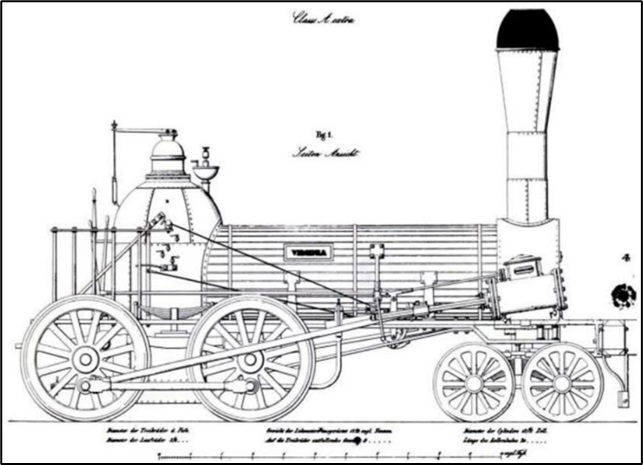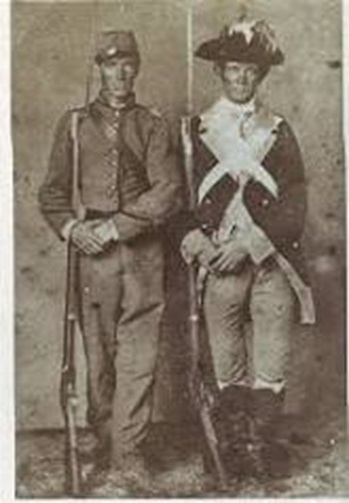Within a matter of hours news of John Brown’s attack on Harper’s Ferry had gotten out to neighboring towns via telegraph and word of mouth. While attending a ball in Winchester, George Kurtz of the Continental Morgan Guard was made aware of Brown’s raid. Kurtz and Captain Hugh Low gathered their militiamen, departed the celebration, and headed for the train station.
Members of the Continental Morgan Guard militia unit hurried to the corner of Market and Water Street and boarded the passenger cars belonging to the Winchester and Potomac Railroad. Nobody recorded which locomotive was tasked for the journey. Each of the engines had names though including Ancient, Pocohontas, Farmer, President, Virginia, and Potomac. One of these was quickly pressed into service. The chief engineer, Thomas Robinson Sharp, would pilot the train on its thirty-two-mile journey to Harpers Ferry.

Norris 4-4-0 locomotive like the Ancient, Virginia and Potomac locomotive.
Once at Harper’s Ferry the company disembarked from the train and headed for the armory. They quickly surrounded the firehouse where John Brown was holed up. One member of the unit wrote, “we were in a skirmish line with our guns at port, our thumb on the hammer, and finger on the trigger”. They would remain in the town serving as backup to Robert E. Lee and his team of marines who were tasked with the job of securing the firehouse. The marines would punch a hole in the door of the structure, enter the building, and capture Brown and his band of insurrectionists. The squad of militiamen would remain in the area to until after the trial and execution of Brown and his accomplices to ensure nobody would conduct an operation to free the conspirators.
The Continental Morgan Guard, or Company A 31st Virginia Militia, had begun organizing on June 22, 1855, in Winchester, Virginia. The unit adopted uniforms resembling the pattern of the Continental Army. “The coats were made of blue wool with buff casimire trim. They wore white doe skin breeches, black top boots, buff casimire waist coats, and black tri-corner hats. The hats were trimmed with the brass numbers 1776 on them, a powder horn device made of brass on a leather cockade, and a flowing white swan plume. They also wore white ruffled shirts and white gloves to complete the outfit.”

Continental Guard and Soldier in Regular Dress.
Each member was required to secure for himself a uniform within sixty days of his election to the company. “It was an expensive outfit, costing more than some could afford. Much effort was expended in helping the volunteers with expenses, however. On April 3rd, 1857, for example, “the ladies of Winchester held a fair for the benefit of the ‘CMG’. The proceeds were enough to uniform fifteen new members who couldn’t pay for the cost of the uniforms otherwise.”
On April 18, 1861, just six days after the firing on Fort Sumter, the “Continental Morgan Guards” enlisted in the Confederate Army. “On June 4th, they would become the oldest company assigned to the 5th Virginia Infantry CSA as Company K with 133 officers and men.
The 5th Infantry Regiment would be commanded by 59-year-old Colonel Kenton Harper. Harper had worn many hats including “newspaper editor, soldier, Indian agent, plantation owner, banker and politician.” He was also an officer of the Virginia militia which was then the U.S. Army during the Mexican War. Eight days after having been given command of the 5th Virginia he helped General William H Harman lead a force of 2,400 men to seize the U.S. Army arsenal located at Harper’s Ferry. Four thousand muskets and thousands of tools were taken and sent to Tredegar Iron Works in Richmond to aid the war effort.
As far as the makeup of the regiment eight companies of the 5th Virginia Infantry would come from Augusta County and two from Frederick. On April 27, 1861, the 2nd, 4th, 5th, 27th, and 33rd Virginia infantry regiments, along with the Rockbridge Artillery Battery, were combined into what was to be called “Virginia’s First Brigade” and placed under the command of Brigadier General Thomas J. Jackson. During the war, the members would serve under Generals Thomas Jackson, Richard Garnett, John Winder, Elisha Paxton, John Walker, and William Terry.
Four companies from the regiment, including Company K, saw their first action at the Battle of Hoke’s Run, also known as the Battle of Falling Waters or Hainesville, which took place on July 2, 1861, in Berkeley County. The fighting was more a skirmish than a battle. Losses were light with the regiment suffering a total of eight casualties. Company K had just one of its members wounded.
In mid-July the 1st Brigade was ordered to join the main confederate army at Manassas. Outsmarting and outmaneuvering their Union adversary, General Robert Patterson, the unit departed from Winchester on July 18, marching thirty miles to Piedmont. Following breakfast, the soldiers were loaded onto railway cars belonging to the Manassas Gap Railroad for the thirty-four-mile train ride to Manassas. Disembarking at the junction the brigade marched to the battlefield and went into camp near Blackburn’s and Mitchell’s Ford, occupying the Confederate right flank along Bull Run.

Map of Bull Run Battlefield showing the 5th Virginia on the right of Jackson’s Line.
As the fighting began to heat up on the Confederate left flank on July 21, the 5th Virginia was sent to the right to reinforce Longstreet while the rest of the brigade marched two miles to the left of the line. When it became clear that the action at the fords was a feint, the 5th trooped to Henry House Hill and fell in on the brigade’s right flank. Jackson’s “instructions were to wait, fire, and charge the enemy as they appeared over the crest, about fifty yards in front.”
Soldiers from Generals Bee and Evans’ Brigades were eventually forced to retreat from their advanced position. As they did so General Barnard Bee’s big moment came as he attempted to halt the retreat of his own soldiers. One story says Bee questioned Colonel Kenton Harper of the 5th Virginia asking: “What troops are these?” Harper replied, “Fifth Virginia Regiment, Jackson’s Brigade.” Bee turned and shouted to his men: “Rally men, rally! Look! These Virginians stand like a stone wall.” In doing so he gave the Brigade and Jackson their famous moniker.
About 2 p.m. Griffin’s and Ricketts’ Batteries were sent to an exposed position on the right of the Union line. A duel ensued between these guns and those belonging to General Jackson. The 33rd regiment advanced toward the guns and released a volley that devastated the union gunners. Jackson presently ordered a charge with the bayonet. “Yelling like furies” the 5th Regiment joined the rest of the brigade charging toward the enemy.
When the charge was ordered on the Union artillery in their front every company in the 5th Virginia claimed to be the first to reach the guns. Undoubtedly the members of Company K were mixed in with the crowd. The assault marked the climax of the Battle of Bull Run. The regiment suffered moderate casualties in the fighting. Of the 570 members of the regiment on the field that day there were 39 casualties. Eleven were killed and twenty-eight were injured. Company K suffered just four wounded.
Accounts from the battle tell us there were grey and blue uniforms worn by both adversaries during the battle. Both sides had contingents that sported colorful Zouave uniforms. “Many of their units donned all-gray outfits; many other poorer companies wore civilian clothes. Brigadier Generals Thomas Jackson and Barnard Bee, for example, dressed in their U.S. Regular Army dark blue uniforms.” “The thick black smoke made it extremely difficult for the commanders to identify the enemy. Rather than identify the gray clad regiments, officers ordered their men to fire.” “Friendly fire thus killed or wounded many Soldiers,” maybe even Brigadier General Bee.
What we do know from records left behind, the members of Company K were dressed in their unique Revolutionary War garb during this their first major battle. We cannot be certain, however, if the tradition carried on throughout the war. What we do know is the company would fight with Jackson in his famous Valley Campaign at Kernstown, 1st Winchester, and Port Republic. They would participate in all the campaigns of the Army of Northern Virginia throughout the war. The company would surrender fewer than a dozen of the 92 men left in the regiment at Appomattox Court House. Regardless of how they were clothed, members of Company K gave their all for the cause in which they believed.
5th Virginia Infantry. H. E. Howard, Inc. Lynchburg, Va. 1988.